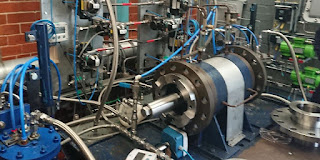Hi everyone, I would like to share some notes and questions on certifying non electrical equipment in hazardous areas using the methods outlined by the ISO standard - 80079-36 & 37.
This is used to self-certify legacy equipment as ‘safe’, and is significantly cheaper than buying expensive ATEX rated equipment! having saved 10s of thousands of £££s in the many project I’ve worked on.
 |
| Figure 1: Generic mechanical equipment |
Typically a risk assessment table is filled out, with example scenarios on how an ignition source can occur, its safety system in place, giving a resulting equipment protection level (EPL) (hazardous zone). Improvements to the safety guards like maintenance procedures, monitoring system, etc, may also be given as a result to achieve compliance.
 |
| Figure 2: Risk assesment table example from ISO 80079-36 |
The following are some questions when undertaking
this assessment.
Please comment, like and subscribe...
 |
| Photograph 1: Generic pump opened up showing shaft and flanges |
1. Can there be frictional heating of impeller mechanical seals between rotating shaft in stationary outer part? - May not be likely as this part will be immersed and cooled with process fluid
2. Can faulty bearings go undetected for some time – leading to the motor cooling fan blades hitting the cowling? (applicable to other rotary equipment like conveyors and fans, etc.)
(1) Can unchecked faulty bearings now be considered to be run in ‘normal operation’ ?
(2) Are the bearings replaced at regular intervals, regardless of condition? See a typical bearing failure bath tub curve
 |
| Figure 3: Typical bath tube curve for bearings |
3. For the pump lubrication oil system:
(1) Is there an alarm present if there is a leak on the liquid seals?
(2) Are the seals monitored for flow out or pressure inside?
(3) Is there any consequence for incorrect type of lubrication oil used for the pump?
(4) Is there any issues for using contaminated or degraded oil? E.g. static discharges into a gas zone?
(5) Is under and over lubrication an issue?
4. Is there a limit on the amount of insulting surfaces inside the pump?
(1) This is to prevent brush discharges, e.g. during cleaning operations, plastic parts can be rubbed to clean them, leading to brush discharges
(2) There should be a limit of insulating surfaces depending on gas group, as per IEC 60079-32, e.g. 5,000 mm2 for IIA, 2,500 mm2 for IIB, etc.
5. Typical Safeguards:
(1) For the Planned Preventative Maintenance (PPM) routines:
i. Is there a check, lubrication and greasing of bearings periodically?
ii. Is there a visual check for faulty bearings?
iii. Are regular thermography undertaken on motor/equipment?
(2) Are approved seals used & maintained in accordance with the manufacturers’ instructions?
(3) Can you have the pump’s amperage sensor on the motor and link it to an alarm and trip? Is this an adequate safeguard for abnormal operation, overheating, etc?
(4) For ‘Ex’ rated motors – are the flange gaps for ‘Ex d’ flameproof enclosures ensured that it is not painted over or otherwise blocked (as this may compromise sealing)?
 |
| Figure 4: Thermal imaging of pump motor |
Screw conveyor:
1. Can trapped powders within mechanical seals become heated to ignition temperature?
2. Is the bending of screw or main shaft by powder weight credible?
3. For tramp metal – is there filter/screening quality control process? Is rusting credible?
4. Is charge accumulation on screw conveyor body by powder movement possible?
(1) Can there already be charge on feed powders?
(2) Infeed powder may generate static or inherently have static charges present (charge relaxation time)
(3) Are the powders fed from earthed bodies/locations?
(4) What is the powder resistivity? – typically high for organic powders like flour – difficult to charge.
 |
| Figure 5: Generic screw conveyor componants |
5. Safeguards (some similar to the pump system)
(1) Is there a check for trapped powders around rotating seals?
(2) Is the equipment run in short duration batches? This may allow a degree of cooling
(3) Is the running rotational speed expected to be slow?
(4) Is there checks for rusting?
(5) Is there clearance inherent in the design of motor fan? Maybe this has changed over time due to rust or deposited/built up layers?
(6) Is the shaft welded or screwed in? is the screw strength/torque checked as part of PPM?
 |
| Figure 6: Screw conveyor shaft failure |
Reactor Agitator:
1. Is rotating the shaft in the wrong direction an issue?
2. Can a failed agitator or malfunction cause a chemical reaction runway potential? Is there any safeguards like process control or operating procedures of this?
3. Drive system issues:
(1) Is misalignment of agitator drive possible? This is usually the cause for increased load bearings, gears and seal damage
(2) Has the agitator installation been verified using laser alignment and by a competent engineer?
(3) Does the agitator drive belt need to be anti-static?
(4) Is there a pressure testing system on the vessels prior to starting a new batch – to check for faulty/leaky bearings?
 |
| Figure 7: Generic reactor agitator |
Thank you for reading, please comment, like and subscribe to this blog
Hope you have enjoyed reading this
Chiraq




